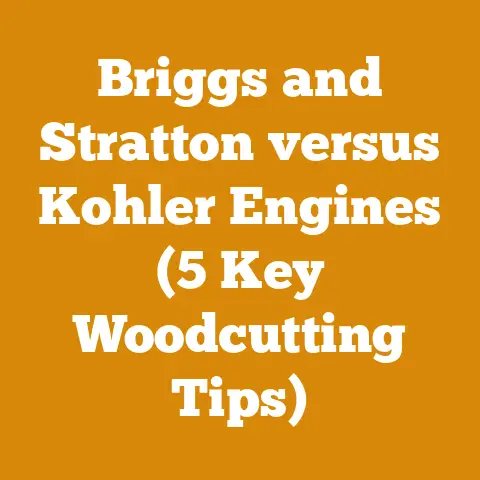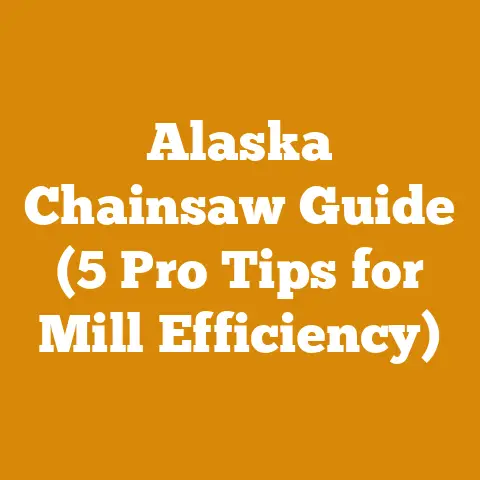Stihl Refurbished Chainsaw: Classic Power (5-Time-Tested Tips)
Let’s talk about Stihl refurbished chainsaws and how to get the most out of them. I believe a refurbished Stihl chainsaw can be your best option for reliable power without breaking the bank. I’ve spent years in the woods, felling trees, processing firewood, and maintaining my own equipment. I’ve learned a thing or two about what makes a chainsaw tick, and more importantly, what makes it last. Purchasing a refurbished Stihl can be a smart move, offering a great balance of cost and performance if you know what to look for. So, let’s get into my 5-time-tested tips to ensure you get a “classic power” Stihl refurbished chainsaw.
Stihl Refurbished Chainsaw: Classic Power (5-Time-Tested Tips)
1. Understanding the Refurbishment Process: What to Look For
Before diving into specific models, I want to cover the refurbishment process itself. A good refurbishment should go beyond just cleaning and a fresh coat of paint. It’s about restoring the chainsaw to optimal working condition.
What a Quality Refurbishment Includes:
- Complete Disassembly and Inspection: Every part should be taken apart, cleaned, and inspected for wear or damage. This includes the engine, carburetor, fuel lines, oil pump, and chain brake.
- Replacement of Worn Parts: This is crucial. Look for evidence that key components like piston rings, spark plugs, fuel filters, and air filters have been replaced. Ask the seller for a detailed list of replaced parts.
- Carburetor Adjustment and Tuning: A properly tuned carburetor is essential for smooth starting, efficient fuel consumption, and optimal power.
- Chain Brake Functionality Check: Safety first! The chain brake must engage quickly and reliably. Test it thoroughly.
- Bar and Chain Inspection: The bar should be straight and the chain sharp. If the bar is worn or the chain is dull, factor in the cost of replacement.
- Pressure Testing: The engine should undergo pressure testing to ensure proper sealing and compression. This is a good indicator of overall engine health.
Red Flags to Watch Out For:
- Vague Descriptions: If the seller is hesitant to provide details about the refurbishment process, be wary.
- Cosmetic Refurbishment Only: A shiny exterior doesn’t guarantee a mechanically sound chainsaw.
- Missing Parts: Check for all the essential components, including the chain guard, spark plug wrench, and instruction manual.
- Excessive Wear: Look for signs of heavy use, such as deep scratches, worn sprockets, or damaged housings.
My Personal Experience: I once bought a “refurbished” chainsaw from a private seller that turned out to be a disaster. It looked great on the outside, but after a few hours of use, the engine seized up due to worn piston rings. I learned my lesson the hard way: always ask for details and don’t be afraid to inspect the chainsaw thoroughly.
Actionable Metric: Ask the seller for a compression test reading. A healthy engine should have a compression reading within the manufacturer’s specifications (usually around 120-150 PSI).
Takeaway: A thorough understanding of the refurbishment process will help you identify a quality chainsaw and avoid potential problems down the road.
2. Model Selection: Choosing the Right Stihl for Your Needs
Stihl offers a wide range of chainsaws, each designed for specific applications. Choosing the right model is crucial for maximizing performance and longevity.
Common Stihl Models for Refurbishment:
- Stihl MS 170/180: Entry-level chainsaws perfect for light-duty tasks like pruning, trimming, and cutting small firewood. They are lightweight and easy to handle, making them ideal for homeowners.
- Stihl MS 250: A step up from the MS 170/180, the MS 250 offers more power and is suitable for cutting larger firewood and felling small trees. It’s a popular choice for homeowners and occasional users.
- Stihl MS 261: A professional-grade chainsaw known for its reliability, power, and durability. It’s a good option for those who need a chainsaw for more demanding tasks like felling larger trees and commercial firewood production.
- Stihl MS 290/291: A mid-range chainsaw that offers a good balance of power and affordability. It’s suitable for a variety of tasks, including firewood cutting, storm cleanup, and occasional tree felling.
Matching the Chainsaw to Your Needs:
- Frequency of Use: How often will you be using the chainsaw? If you only need it occasionally for light-duty tasks, an entry-level model like the MS 170/180 might suffice. If you plan to use it regularly for more demanding tasks, consider a professional-grade model like the MS 261.
- Size of Trees: What size trees will you be cutting? For small trees and branches, a smaller chainsaw with a shorter bar is sufficient. For larger trees, you’ll need a more powerful chainsaw with a longer bar.
- Type of Wood: What type of wood will you be cutting? Hardwoods like oak and maple require more power than softwoods like pine and fir.
- Budget: How much are you willing to spend? Refurbished chainsaws can range in price depending on the model, condition, and seller. Set a budget and stick to it.
My Personal Experience: I started with an MS 180 for basic tasks around my property. As my firewood needs grew, I upgraded to an MS 261. The difference in power and performance was significant. The MS 261 handled larger logs with ease and made the job much faster and more efficient.
Actionable Metric: Consider the bar length. A good rule of thumb is to choose a bar length that is at least 2 inches longer than the diameter of the largest tree you plan to cut.
Takeaway: Choosing the right Stihl model for your needs is essential for maximizing performance, extending the life of the chainsaw, and ensuring your safety.
3. Inspection Checklist: What to Look for Before You Buy
Before handing over your money, I want to stress the importance of a thorough inspection. Don’t rely solely on the seller’s description. Take the time to examine the chainsaw carefully and ask questions.
External Inspection:
- Housing: Check for cracks, breaks, or excessive wear. A damaged housing can compromise the chainsaw’s structural integrity.
- Bar: Inspect the bar for straightness, wear, and damage. Make sure the rails are in good condition and the sprocket turns freely.
- Chain: Check the chain for sharpness, damage, and proper tension. The chain should fit snugly on the bar and move freely.
- Controls: Test all the controls, including the throttle, choke, and on/off switch. Make sure they operate smoothly and correctly.
- Chain Brake: Engage and disengage the chain brake several times to ensure it functions properly. The chain should stop immediately when the brake is engaged.
Internal Inspection:
- Air Filter: Remove the air filter and inspect it for dirt and debris. A clogged air filter can restrict airflow and reduce engine performance.
- Spark Plug: Remove the spark plug and inspect it for wear, damage, and proper gap. A fouled spark plug can cause starting problems and misfires.
- Fuel Filter: Check the fuel filter for cleanliness. A clogged fuel filter can restrict fuel flow and cause engine stalling.
- Oil Reservoir: Check the oil reservoir for leaks. The chainsaw should automatically oil the chain while it’s running.
Starting and Running:
- Cold Start: Observe how easily the chainsaw starts when cold. It should start within a few pulls.
- Idle: Listen to the engine idle. It should idle smoothly without stalling or sputtering.
- Throttle Response: Test the throttle response. The engine should rev up quickly and smoothly when you squeeze the throttle.
- Smoke: Observe the exhaust smoke. Excessive smoke can indicate engine problems.
- Chain Oiling: Check to see if the chain is being oiled properly when the chainsaw is running.
My Personal Experience: I once inspected a refurbished chainsaw that looked great at first glance. However, upon closer inspection, I noticed a crack in the housing near the handle. This could have been a serious safety hazard, so I passed on the purchase.
Actionable Metric: Check the spark plug color. A tan or light brown color indicates proper combustion. A black or oily spark plug indicates a problem.
Takeaway: A thorough inspection is crucial for identifying potential problems and ensuring that you’re getting a quality refurbished chainsaw. Don’t be afraid to ask questions and take your time.
4. Negotiation Tactics: Getting the Best Price
Negotiating the price of a refurbished chainsaw can save you money. Here are some tactics I’ve used successfully over the years:
Research Market Value:
- Check Online Listings: Look for similar refurbished Stihl chainsaws on eBay, Craigslist, and other online marketplaces. This will give you a good idea of the current market value.
- Compare Prices: Compare prices from different sellers. Don’t be afraid to contact multiple sellers and ask for their best price.
- Consider Condition: Factor in the condition of the chainsaw. A chainsaw in excellent condition is worth more than one in fair condition.
Identify Flaws:
- Point Out Imperfections: During the inspection, point out any flaws or imperfections you find. This can give you leverage during negotiations.
- Estimate Repair Costs: If you identify any potential repairs, estimate the cost of those repairs and use that as a bargaining chip.
Make a Reasonable Offer:
- Start Low: Start with a low but reasonable offer. Be prepared to negotiate.
- Be Prepared to Walk Away: Don’t be afraid to walk away if the seller is unwilling to negotiate. There are plenty of other refurbished chainsaws out there.
Bundle Deals:
- Ask for Extras: Ask the seller to include extras like a new chain, bar oil, or a carrying case.
- Offer Cash: Offer to pay in cash. Some sellers are willing to offer a discount for cash payments.
My Personal Experience: I once negotiated the price of a refurbished MS 261 by pointing out a small crack in the chain brake handle. The seller initially refused to budge on the price, but after I showed him the crack and explained that I would have to replace the handle, he agreed to lower the price by $50.
Actionable Metric: Aim to negotiate a price that is 10-20% below the average market value for a similar refurbished chainsaw in comparable condition.
Takeaway: Negotiation is a key part of the buying process. By doing your research, identifying flaws, and making a reasonable offer, you can get the best possible price on your refurbished Stihl chainsaw.
5. Maintenance and Care: Extending the Life of Your Chainsaw
Once you’ve purchased your refurbished Stihl chainsaw, proper maintenance and care are essential for extending its life and ensuring its optimal performance.
Regular Maintenance:
- Sharpen the Chain: Keep the chain sharp. A dull chain will make the chainsaw work harder and can damage the engine. I recommend sharpening the chain after every few hours of use.
- Clean the Air Filter: Clean the air filter regularly. A clogged air filter can restrict airflow and reduce engine performance. I clean mine after every use.
- Check the Spark Plug: Inspect the spark plug regularly and replace it as needed. A fouled spark plug can cause starting problems and misfires. I replace mine annually.
- Clean the Carburetor: Clean the carburetor periodically. A dirty carburetor can cause starting problems and poor engine performance. I clean mine every six months.
- Check the Fuel Filter: Check the fuel filter regularly and replace it as needed. A clogged fuel filter can restrict fuel flow and cause engine stalling. I replace mine annually.
- Lubricate the Bar and Chain: Keep the bar and chain lubricated. Proper lubrication reduces friction and wear. I use a high-quality bar and chain oil.
Storage:
- Drain the Fuel: Drain the fuel tank before storing the chainsaw for extended periods. Gasoline can degrade and damage the carburetor.
- Clean the Chainsaw: Clean the chainsaw thoroughly before storing it. Remove any dirt, debris, and sawdust.
- Store in a Dry Place: Store the chainsaw in a dry place. Moisture can cause rust and corrosion.
Safety Precautions:
- Wear Safety Gear: Always wear safety gear when operating a chainsaw, including eye protection, hearing protection, gloves, and sturdy footwear.
- Read the Manual: Read the owner’s manual carefully before operating the chainsaw.
- Be Aware of Your Surroundings: Be aware of your surroundings and avoid cutting near power lines or other hazards.
- Never Operate a Chainsaw When Tired or Under the Influence: Never operate a chainsaw when you are tired, under the influence of alcohol, or taking medication that can impair your judgment.
My Personal Experience: I’ve learned the importance of regular maintenance the hard way. I once neglected to clean the air filter on my chainsaw, and it ended up causing the engine to overheat and seize up. Now, I’m meticulous about maintenance and follow a strict schedule.
Actionable Metric: Keep a maintenance log. Record the date and type of maintenance performed on your chainsaw. This will help you track your progress and identify potential problems early on.
Takeaway: Proper maintenance and care are essential for extending the life of your refurbished Stihl chainsaw and ensuring its optimal performance. By following a regular maintenance schedule and taking safety precautions, you can enjoy years of reliable service.
In conclusion, purchasing a refurbished Stihl chainsaw can be a smart and cost-effective way to get a reliable and powerful tool. By understanding the refurbishment process, choosing the right model, performing a thorough inspection, negotiating effectively, and practicing proper maintenance, you can ensure that you get a “classic power” Stihl chainsaw that will serve you well for years to come. Remember to always prioritize safety and follow the manufacturer’s instructions. Happy cutting!






